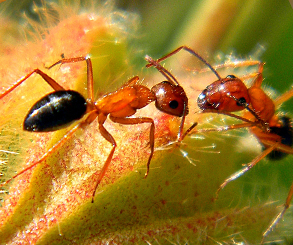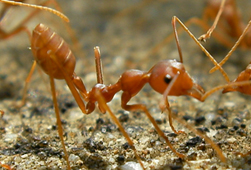Red Imported Fire Ants & Native Fire AntsApril Pest of the Month.

What are they & what causes them?
Ants can lift many times their own weight and make up about 10% of the earth’s biomass. Fire ants are invasive and can be in all Florida counties and southern United States. Worker ants may vary in size but all are capable of stinging. Fire ants both sting and bite. They spread by swarming. Red Imported Fire Ants were first introduced to Mobile Alabama from Brazil around the 1930’s. It takes several months for a colony to get large enough to be noticed in the average home lawn.
(photo to the left (RIFA) courtesy of: Flickr user Bob in Swamp, Photographer: Bob Peterson)
Jump to section: Appearance | Symptoms | Habitat | Treatment | More Information
Also see our other April Pest of the Month: Fleas
General Appearance
Red Imported Fire Ants (RIFA): have two powerful mandibles for biting, cutting, digging and carrying.
- Color: dark reddish-brown with a black abdomen
- Total segments: 3; head, thorax and abdomen
- Size: 1/8" – 3/8"
- Shape: oval; segmented
- Legs: 6
- Nest (or colony): these ant mounds will be round, softball sized to basketball size. Many worker ants do not have disproportionate head to body ratios.
Native Fire Ants: have a mandible with 4 teeth for biting, cutting, digging and carrying.
- Color: Red brown
- Size: 1/32" – 1/4"
- Shape: oval; segmented
- Legs: 6
- Nest (or colony): these ant mounds will be low, flat and irregular shaped. Many range from fist size to several feet long/wide. Worker ants have square shaped heads that are larger in proportion to the rest of their body.
Also see our April 2015 eNewsletter: Ants Go Marching!
Symptoms

The most common signs of any fire ant activity are seeing the worker and swarmer ants.
Other signs are their sandy ant mounds and people stating they’ve been stung by ants.
(photo to the left (Native Fire Ant) courtesy of: Flickr user Marufish)
Red Imported Fire Ants are typically densely occupied and contain in upwards of 250,000 ants. They can build nests below sidewalks, within wall voids, under carpeting, in water meter casing and even in TV sets and computers.
Habitat
All types fire ants can do a wide range of damage to homes, crops, trees, electrical equipment and many other structures. Fire ants frequently invade home lawns, school yards, athletic fields, electrical equipment, pavement cracks as well as parks and recreational areas.
Fire Ants are attracted to electrical junction boxes (such as AC and sprinkler systems). They are known to eat meats, greasy and sweet materials. They favor warm and sunny conditions and prefer open fields with direct sunlight. They may nest in open areas near watered lawns, gardens, ball fields, golf courses, irrigated fields, lakes, ponds, rivers and streams.
Also see our April 2015 eNewsletter: Ants Go Marching!
Treatment
The best method to eliminate fire ants is to have us come out and perform an inspection to determine the best course of action for eliminating these pests in your home.
We currently offer mound treatments and wide-area broadcast applications. Live Oak Pest Control utilizes multiple strategies to control fire ants. Our first approach is two broadcast applications followed by an individual mound drench using a liquid insecticide.
Also see our other April Pest of the Month: Fleas
More Information
- Red Imported Fire Ants | Desert USA
- Red Imported Fire Ant | Featured Creature UF IFAS
